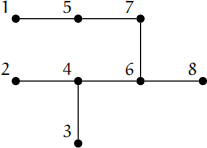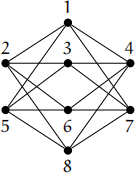MTH6105: Algorithmic Graph Theory Main Examination period 2022
Hello, dear friend, you can consult us at any time if you have any questions, add WeChat: daixieit
Main Examination period 2022 – May/June – Semester B
MTH6105: Algorithmic Graph Theory
Question 1 [24 marks].
(a) Give the Pr¨ufer code of the following tree. [4]

(b) Give the degree sequence of the tree with Pr¨ufer code 6,4,3,2,1,6,4,6. Show your working. [6]
(c) Draw a tree with degree sequence 3,3,2,2,1,1,1,1. [2]
(d) Show that any connected graph with degree sequence 3,3,2,2,1,1,1,1 must be a tree. [6]
(e) Give an efficient algorithm that, for any sequence d1 ,d2 , . . . ,dn that is the degree sequence of a tree, constructs a particular tree with that degree sequence. Explain briefly why the algorithm is correct and efficient. [6]
Question 2 [22 marks]. Consider the network (G,w) with
V(G) = {u,a,b,c,d,e,f,g},
E(G) = {ua,ub,uc,ac,ad,af,bc,bg,cd,ce,df,eg,fg}, and
w(ua) = 6, w(af) = 1, w(df) = 4,
w(ub) = 3,
w(bc) = 1,
w(eg) = 6,
w(uc) = 1,
w(bg) = 5,
w(fg) = 1.
w(ac) = 4,
w(cd) = 1,
w(ad) = 2,
w(ce) = 1,
(a) Draw G. [2]
(b) Apply Dijkstra’s algorithm to (G,w) starting from vertex u. Give V(T) and E(T) after each iteration of the algorithm. [10]
(c) For each v ∈ V(G), give the length of a shortest u−v-path in (G,w). Justify your answer. [4]
(d) Show that the tree T obtained in Part (b) is the unique minimum spanning tree of (G,w). [6]
Question 3 [26 marks]. Consider the directed network (D,c) given by the following drawing, where each arc e ∈ A(D) is labelled by its capacity c(e) and two vertices s and t have been identified.

(a) Use the Ford-Fulkerson algorithm to find a maximum s−t-flow of (D,c). Draw the residual network after each iteration of the algorithm, and give the size of the maximum flow. [14]
(b) Use a cut to show that the flow you have found is indeed a maximum s−t-flow of (D,c). [6]
(c) If the capacity of exactly one of the arcs with capacity 4 was increased to 5, would this affect the size of a maximum flow? Justify your answer. [6]
Question 4 [28 marks].
(i)  (ii)
(ii) 
Consider the bipartite graph G given by the following drawing, where each vertex is labelled with its name.

(b) Show that M = {u2v5 ,u3v4 ,u5v2 ,u6v1} is a matching of G.
(c) Find a maximum matching of G. Show your working.
(d) Use Hall’s theorem to show that the matching you have found is indeed a maximum matching.
Call a graph H regular if there exists k ≥ 1 such that dH (v) = k for all v ∈ V(H).
(e) Does there exist a regular graph H with V(H) = V(G) and E(H) ⊆ E(G)? Justify your answer. [6]
2023-05-28